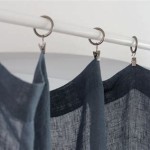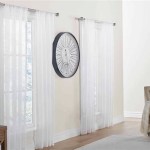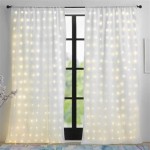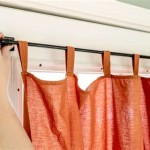How To Temporarily Hang Curtains
Hanging curtains can dramatically transform a room, adding both style and functionality. However, permanent installations can be a commitment. Temporarily hanging curtains provides a flexible solution for renters, those experimenting with decor, or individuals needing privacy or light control without the permanent fixtures. This method allows for easy removal and minimal damage to walls, making it an attractive option for various situations. This article will explore several methods for temporarily hanging curtains, focusing on ease of installation, minimal wall impact, and cost-effectiveness.
Using Tension Rods for Lightweight Fabrics
Tension rods present a straightforward approach to hanging curtains temporarily. These rods utilize spring tension to maintain their position within a window frame, eliminating the need for screws, nails, or other permanent fasteners. This method is best suited for lightweight fabrics, such as sheer curtains or lightweight cotton panels, as excessive weight can cause the rod to slip or fall.
The installation process begins with measuring the width of the window frame where the curtains will be hung. It is crucial to obtain an accurate measurement to select the appropriate size tension rod. Most tension rods are adjustable within a specific range, so choosing one that comfortably fits the window width is essential. Once the rod is selected, the next step involves adjusting the rod to slightly longer than the measured width. This ensures sufficient tension to hold the rod securely in place.
To install the tension rod, position it within the window frame at the desired height. Compress the rod by pushing inward on one end, then carefully maneuver it into place. Gradually release the pressure, allowing the spring mechanism to expand and exert force against the window frame. It is recommended to test the stability of the rod by gently pulling on it. If the rod feels loose or unstable, readjust the tension until it feels secure. Once the rod is securely in place, the curtains can be hung. Curtains with rod pockets or tabs work best with tension rods, as they can easily slide onto the rod without the need for additional hardware. Distribute the fabric evenly along the rod to ensure a balanced and aesthetically pleasing appearance.
Several factors influence the effectiveness of using tension rods. The type of window frame is a significant consideration. Smooth, non-porous surfaces, such as painted wood or metal, offer better grip than textured or uneven surfaces. Additionally, the weight of the curtains is a critical factor. Overloading the rod with heavy fabrics can compromise its stability and increase the risk of it falling. Regular checks are advised to ensure the rod remains secure and to readjust the tension as needed.
Command Hooks and Lightweight Rods
Command hooks offer an alternative method for temporarily hanging curtains, particularly when a more secure hold is required than what a tension rod can provide. These adhesive hooks are designed to be removable without damaging walls, making them ideal for renters or those seeking a non-permanent solution. When used in conjunction with lightweight rods, Command hooks can support a wider range of curtain styles and fabrics compared to tension rods alone.
The initial step in this process involves selecting the appropriate Command hooks based on the weight of the curtains and the rod. Command products are available in various sizes and weight capacities, so it is crucial to choose hooks that can adequately support the intended load. It is always advisable to err on the side of caution and select hooks with a higher weight capacity than the estimated weight of the curtains and rod. Clean the wall surface where the hooks will be placed. Use a clean cloth dampened with rubbing alcohol to remove any dirt, dust, or grease that may interfere with the adhesive bond. Allow the surface to dry completely before proceeding.
Follow the instructions provided on the Command hook packaging to attach the hooks to the wall. Typically, this involves removing the protective backing from the adhesive strips and firmly pressing the hooks against the cleaned surface. Apply consistent pressure for the recommended duration, usually around 30 seconds, to ensure a strong bond. Allow the adhesive to cure for the specified time, typically one hour, before hanging the rod and curtains. This curing period allows the adhesive to fully set and achieve its maximum holding strength.
Once the hooks are securely in place, a lightweight rod can be hung between them. Options include thin metal rods, wooden dowels, or even plastic pipes. The choice of rod depends on the desired aesthetic and the weight of the curtains. Ensure the rod is lightweight enough not to exceed the weight capacity of the Command hooks. Curtains with rod pockets, tabs, or rings can be easily attached to the rod. Distribute the fabric evenly along the rod for a balanced look. To remove the Command hooks, gently pull down on the adhesive strip, following the instructions provided on the packaging. The adhesive strip should stretch and release from the wall without causing any damage.
Successfully using Command hooks relies on several key factors. Proper surface preparation is crucial for optimal adhesion. Ensure the wall is clean, dry, and free of any loose paint or wallpaper. Avoid using Command hooks on delicate surfaces, such as wallpaper or freshly painted walls, as they may be prone to damage. Regularly check the hooks to ensure they remain securely attached to the wall. If any hooks appear to be loosening, consider replacing them with new ones. Distributing the weight of the curtains evenly along the rod can help prevent excessive stress on individual hooks.
Using Fabric Tape or Hemming Tape for Temporary Panels
For a truly temporary and damage-free option, consider using fabric tape or hemming tape to create temporary curtain panels. This method is particularly well-suited for situations where a quick solution is needed, such as for privacy during a party or for blocking light in a temporary workspace. Fabric tape, also known as fusible tape or hemming tape, is a double-sided adhesive that bonds fabric together when heated with an iron. This allows individuals to create simple curtain panels without sewing, providing a very fast and easy solution.
The process begins with selecting the fabric for the temporary curtain panels. Lightweight fabrics, such as cotton, linen, or sheer materials, work best for this method. Measure the window or area where the curtain will be hung and cut the fabric to the desired dimensions, allowing for extra length at the top for creating a makeshift rod pocket. Fold the top edge of the fabric over to create a pocket that is wide enough to accommodate a curtain rod or dowel. The size of the pocket will depend on the diameter of the rod or dowel being used.
Place the fabric tape between the folded edge of the fabric and the main body of the fabric panel. Ensure the tape is positioned close to the folded edge to create a strong bond. Follow the instructions on the fabric tape packaging to fuse the fabric together. Typically, this involves using a hot iron to apply heat and pressure to the taped area. Move the iron slowly and evenly over the tape, ensuring the entire area is heated. Allow the fabric to cool completely before handling. Once the fabric has cooled, the temporary rod pocket will be securely fused together.
The next step involves creating a method for temporarily attaching the curtain panel to the window or wall. Options include using safety pins, binder clips, or even more fabric tape. Attach the chosen clips or pins to the top of the curtain panel, spacing them evenly along the width of the panel. These clips or pins can then be used to attach the curtain to an existing curtain rod, a wire, or even directly to the window frame. If using fabric tape, apply strips of tape to the back of the curtain panel at the top edge. Then, carefully press the curtain against the window frame or wall to secure it in place.
This method is extremely temporary and easy to implement. However, it is essential to consider the limitations. Fabric tape is not designed to hold heavy fabrics, so it is best suited for lightweight materials. The adhesive may not be strong enough to withstand significant stress, so handle the curtain panel with care. When removing the curtain panel, carefully peel the fabric tape away from the wall or window frame. Residue may be left behind, but it can usually be removed with a mild detergent or adhesive remover. This option offers a quick and cost-effective solution for creating temporary curtains, but it is not intended to be a long-term or durable option.
In summary, temporary curtain hanging methods offer versatile solutions for various needs. The chosen method should align with the fabric weight, desired aesthetic, and the length of time the curtains are intended to be displayed. Each option presents its advantages and limitations, allowing individuals to select the most suitable technique for their specific circumstances.

How To Hang Curtains The Right Way Painting By Penny

How To Hang Curtains 15 Steps With Pictures Wikihow

5 Easy Ways To Hang Curtains Without Drilling
Creative Diy Ways For Hanging Curtains Without Rods

How To Hang Curtains Without Drilling

Easy Ways To Hang Curtains For Temporary Homes

How To Hang Curtains Like A Pro Diy Darling

5 Easy Ways To Hang Curtains Without Drilling

How To Hang A Curtain Rod Without Drilling Into The Wall

How To Hang Curtains With Crown Molding The Shade








